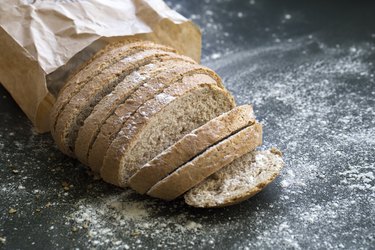
Multigrain bread benefits are many, as long as the bread is 100 percent whole grain. Eating whole grains helps to lower your risk of diseases like stroke, diabetes and heart disease, according to the Cleveland Clinic. So enjoy that slice of multigrain bread.
Tip
Multigrain bread has many nutritious advantages over white bread, especially if it's 100 percent whole grain. Whole grains are rich in protein, fiber and B vitamins, and provide you with complex carbohydrates that help you to feel satiated.
Video of the Day
Multigrain Bread Benefits
When you buy multigrain bread, look for the 100 percent whole grain label. That will give you the benefits of whole grains, without the drawbacks of refined grains. According to Harvard Health, refined grains are stripped of valuable nutrients when they are processed. Whole grains, however, are a complete package of nutrients.
Video of the Day
Multigrain bread has the advantage of providing a variety of grains, the Cleveland Clinic states. As long as the grains used are 100 percent whole grain, this type of bread can provide you with a nice variety of high-fiber nutrition.
Whole grains that may be in multigrain bread, according to the Mayo Clinic, include barley, brown rice, buckwheat, bulgur, millet, oatmeal, quinoa and whole wheat. Look for those ingredients when you're buying this type of bread.
Multigrain bread isn't always whole grain, however. As Laura Jeffers, a registered dietitian, writes for the Cleveland Clinic, it's not easy to choose the right loaf at the supermarket. Terms like multigrain, seven-grain, 12-grain, organic wheat flour and all-natural can be confusing.
Read more: Why Isn't White Bread Good for You?
What to Look For
When you're buying multigrain bread, look for the ingredients, the Cleveland Clinic reports. That's where you'll learn the grains contained in what you're buying. If the first ingredient is whole wheat flour, or another whole grain, that means the primary ingredient is a whole grain.
If the first ingredient is wheat flour, you won't be getting much in the way of whole grains. The Cleveland Clinic states that wheat flour is actually 75 percent white flour, or refined flour, and 25 percent whole wheat flour, so you're not getting much in the way of whole grains. If you find a bread that is labeled 100 percent whole grain, that means the ingredients are entirely grains with complete nutrients, as Harvard Health states.
Choosing whole grains means you're choosing less-processed, higher quality carb sources. Carbs from whole grains help you feel more full, Harvard Health reports.
Health.gov's 2015-2020 Dietary Guidelines for Americans suggests that you eat 6 ounces of grain daily and get at least half of that from whole grains, based on a 2,000-calorie-per-day diet. Buying bread that is mostly whole grain or 100 percent whole grain will help you get closer to that recommendation.
A study in the December 2013 issue of Public Health Nutrition examined 545 grain products in two supermarkets and found there were many conflicting definitions as to what a whole grain product is. Further, the December 2016 issue of American Journal of Clinical Nutrition reports that nutrition professionals meeting in 2015 determined that a standard definition of whole grains needs to be adopted.
Read more: List of Foods High in Soluble Fiber
Benefits of Multigrain
When looking at calorie content, multigrain bread calories are often equivalent to those of other types of bread. But the fiber content is generally higher. According to USDA FoodData Central, one slice of supermarket company Ahold USA multigrain bread contains 100 calories and 3 grams of fiber.
This product has whole wheat flour as its primary ingredient, and enriched wheat flour as its secondary ingredient. Other grains, which compose less than 2 percent, include barley, flaxseed, millet and wheat bran.
A different type of multigrain bread from Ahold USA, with enriched wheat flour as its primary ingredient, contains 120 calories and one gram of fiber, according to USDA FoodData Central. This is why it's important to read labels of multigrain bread. Multigrain bread calories may be slightly more, but as Harvard Health points out, you feel more full when you eat it.
The benefits of this type of bread, when made from whole grains, include not only fiber, but more vitamins than you get in bread made from enriched flour. Whole grains provide added B vitamins, iron, copper, zinc, magnesium, antioxidants and phytochemicals, Harvard Health states. Antioxidants protect your cells from damage, notes the U.S. National Library of Medicine. Phytochemicals are found naturally in plants and may have a role in preventing disease.
While enriched multigrain breads don't contain the fibrous, chewy bran coating of whole grains, they don't have the added nutritional benefits either. So when you look for bread, if you're seeking extra fiber, vitamins and minerals, look for whole grain ingredients in order to get multigrain bread benefits.
- Harvard Health: "The Nutrition Source: Whole Grains"
- Cleveland Clinic: "Which Bread Is Best For You — Whole-Grain, Multigrain or Whole Wheat?"
- Mayo Clinic: "Whole Grains: Hearty Options for a Healthy Diet"
- Health.gov: "USDA Dietary Guidelines for Americans, 2015-2020: "Chapter 1. Key Elements of Healthy Eating Patterns: A Closer Look Inside Healthy Eating Patterns"
- Public Health Nutrition: "Identifying Whole Grain Foods: A Comparison of Different Approaches for Selecting More Healthful Whole Grain Products"
- American Journal of Clinical Nutrition: "Thinking Critically About Whole-Grain Definitions: Summary Report of an Interdisciplinary Roundtable Discussion at the 2015 Whole Grains Summit"
- U.S. National Library of Medicine: "Antioxidants"
- USDA FoodData Central: "Multigrain Bread"
- USDA FoodData Central: "MultiGrain Bread"
Was this article helpful?
150 Characters Max
0/150
Thank you for sharing!
Thank you for your feedback!